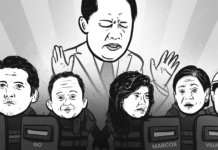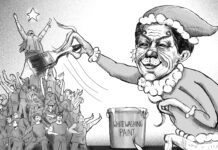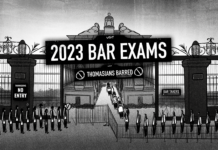IT IS appalling that while Thomasians have been generally scarce on social media on such pressing concerns as corruption in government, the future of Philippine democracy, the persecution and even massacre of Christians in the Middle East, and the removal of crosses in China by communist Beijing, they’ve suddenly become overzealous netizens over the very petty subject of the good-grooming policy of UST. It is likewise appalling that the UST administration, which is otherwise mum on the same urgent issues affecting the Church and society, is fanatically pressing on the same. Now UST is the butt of ridicule on social media for preoccupying itself with the most trifling of matters.
The matter is not even about overall grooming but about hair of all things!
In the University’s Code of Conduct and Discipline, the issue is broadly stated: “Good grooming includes the wearing of the prescribed college uniform, authorized shoes, ID, the male haircut and other considerations that are similar to these.” The same guidelines state in so many words that particular colleges and faculties may decide on how to implement this provision.
But trust UST bureaucrats to widen their turf by liberally interpreting such provisions for their self-aggrandizement and making supercilious demands on students.
We commiserate therefore with former Acting Dean Romeo Castro of the College of Fine Arts and Design (CFAD) for being forced to dig his heels because the local Student Welfare and Development Board (SWDB) has usurped the local administration’s prerogative over the issue and suddenly issued a directive banning such hair styles as “afro,” “undercut,” “funky,” “long hair,” “man bun, “mohawk” and “rat tail”—some of which are styles many lifestyle writers know nothing about and which have raised speculation if the CFAD faculty is really staffed by visual artists and designers and not by Jessie Mendez, Jun Encarnacion, and your good ol’ “parlorista” from Trabajo or Central Market.
We agree with Castro that, against the claim of students whose activism cannot go beyond the petty and puerile, the policy does not violate freedom of expression and anyway, the expression of such right should go beyond “outrageous hairstyles.” But we don’t agree that “afro” and the other banned styles are “outrageous” or run against the general definition of grooming as “neat and clean.” An “afro” haircut can be neater and cleaner than the army cut of a person who is lice-infested, doesn’t cover his mouth when he sneezes, or farts obliviously.
One would think that CFAD would interpret the hair-regulation policy liberally since, after all, it is a school of fine arts. As well for that matter, one would think that CFAD would be concerned more about the fact UST has been hardly figuring for several years in the Shell, MADE, AAP Annual, GSIS, Petron and other important art contests. Heck, UST has not been winning even in its own UST On-the-Spot Painting Contest! But CFAD has chosen to dig its heels on such paltry matters as hair style.
It is laughable that the local SWDB mentions afro as one of the banned hairstyles for two reasons: one, the name of the style obviously draws from “African,” thus making fun of the kinky hair of our African brethren, and also thus betraying the SWDB’s lack of “political correctness” or at the least, Catholic “intercultural tact.” (Whatever has happened to the contextual theology supposedly promoted by the Dominicans!). And second, if one would look at the Thomasian Yearbooks of the 1970’s, one would find graduates from the UST Central Seminary sporting the afro and other “groovy” styles. Many of those graduates with un-“neat” and un-“clean” haircuts have since become bishops, such as Fr. Oscar Solis, now the auxiliary bishop of the Archdiocese of Los Angeles and the first Filipino priest to be elevated to the American episcopacy.
Come to think of it, Jesus Christ wore long hair!
The Lord’s example should indicate that hair styles are determined by age, aesthetics, taste, history, and the generations—a gamut of issues that should preoccupy more Ricky Reyes’ hair institute rather than the Pontifical University.
Moreover, while the SWDB declares ex-cathedra certain hair styles as anathema, it asks the security guards of CFAD to enforce its capricious policies. Blue guards have more pressing security matters to attend to, but in having been given the responsibility to decide which haircut to ban and corollarily, which students to refuse admittance, they have been practically authorized to classify students as “security risks.” But students are not criminals or terrorists. In addition, students are clients of UST; their parents and guardians have paid tuition. For UST to ban tuition-paying students from attending their classes just because certain administrators and teachers don’t like their hair style smacks of estafa!
Ironically enough, over at the Faculty of Arts and Letters, Dean Michael M. Vasco has outdone CFAD as far as “painting” is concerned by saying he would allow outlandish hair colors as blonde, burgundy and brown, and would allow male students with long hair, as long as they look “neat.” His pronouncement hasn’t exactly shaken social media, but at least he has followed the “liberal” tradition fostered by his predecessors who by and large have applied wisely to UST’s student grooming policy the spirit of the English idiom sired by George Eliot in her immortal novel, The Mill on the Floss: “Do not judge a book by its cover.”












